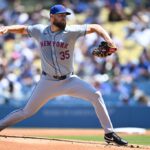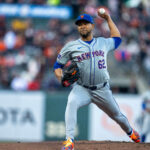Blogger’s Note: I have been thinking about writing a piece about this for awhile. It’s been a tough one to get all out on paper, so I have decided to break this into two parts: one today, one tomorrow. In the meantime, here is Part One of “One Way or Another.” ~ Coop
If you listen to one part of the Mets fan base, this offseason is a bust and Sandy Alderson is a “hack.” The other half says, Alderson is smart for waiting it out and not spending like a drunken sailor, like previous administrations have done. While sexy names like Cliff Lee or Jayson Werth (tongue-in-cheek) have stayed away from Flushing, Sandy Alderson has gotten a lot of the little things right by going after higher-risk and higher-reward types on the open market.
One of the first items on his checklist was to exercise Jose Reyes’ option for the 2011 season, which he did. However, when Reyes recently stated that he didn’t want to negotiate any contract extensions during the season, this perked my ears. The last contract extension he signed was mid-season, in 2006, when the Mets were riding high and they were winning and everyone was happy. So now there’s a bit of a standoff with Reyes and the front office. He is in essence saying “Negotiate now” and the Mets (perhaps rightfully so) are waiting to see how he performs.
One possibility is that injury-prone Reyes could indeed have his break out year, coincidentally with his “walk” year. Surprise, surprise, as he would hardly be the first nor the last to do that. The other possibility is that same injury prone Reyes could be, well, hurt for some time this season, and therefore they don’t want to put the cart before the horse and give him an extension now.
I say hogwash to that. There’s absolutely no reason why Jose Reyes should not warrant at least a three-year extension right now, as his value is probably lower not only for the hometown discount but for his not-so-hot recent playing years, namely 2009 and 2010. For an office that predicates their philosophy on “value,” the time is now for him.
However, barring that happening (it is pretty unlikely), the idea from bloggers, beat writers and the vocal fan is that come 2012, Reyes will no longer be a Met. Here’s the oft-repeated scenario: he’ll have a breakout season, and he’ll ask for “too much money.” The Mets will either: low-ball him in money/years, think he’s “not worth it” or “they’ll be too cheap” to sign him. Though I will attest till I am blue in the face that the Mets have demonstrated that over the course of my fandom, they are a) NOT cheap and b) just dumb with their money and who they spend it on…kicking Reyes to the curb WHETHER OR NOT he has a career year in 2011 at age 28 is an idea that horrifies me.
In Jose Reyes we lose a lot if he walks. We lose a shortstop [please spare me the whole “Ruben Tejada (or Wilmer Flores, depending on who you talk to) is the shortstop of the future” business], we lose a leadoff hitter, we also lose a guy that other teams love to hate. That intangible can’t be quantified yet it’s incredibly tough to replace.
Something people tell me is that Jose Reyes is the antithesis to what Sandy Alderson wants in a leadoff hitter. While I have a ton of respect and intrigue related to sabermetrics and using this as a way to quantify undervalued players, Jose Reyes when he’s healthy is certainly an elite-with-great-potential leadoff hitter. Let’s take a look at his recent stats along with some of the other leadoff hitters through MLB.
| Name | Team | PAs | BA | OBP | BB | K | H | RS |
| Jose Reyes | Mets | 603 | .282 | .321 | 31 | 63 | 159 | 83 |
| Ichiro Suzuki | Mariners | 732 | .315 | .359 | 45 | 86 | 214 | 74 |
| Rajai Davis | A’s | 561 | .284 | .320 | 26 | 78 | 149 | 66 |
| Shane Victorino | Phillies | 648 | .259 | .327 | 53 | 79 | 152 | 84 |
| Jason Bartlett | Rays | 532 | .254 | .324 | 45 | 83 | 119 | 7 |
2010 Stats: Baseball Reference
Please bear in mind the following: I have no idea how many of these Plate Appearances where the hitter was batting in the actual “leadoff” position in the lineup (remember: Jose Reyes even batted third in the lineup for a period of time), this was based on what ESPN has broken out as the “leadoff” hitter in the respective teams’ lineups, and that I personally chose these hitters because they were well-known as “the leadoff hitter” of their respective team in 2010. I also used Plate Appearances as opposed to “At-Bats” since I am paying closer attention to walks, and I feel PAs may be a better assessment for their actual percentages. And, as always, lies, damned lies, and statistics ~ Mark Twain.
Moving right along, the consensus is that a leadoff hitter should have the following components: they need to draw walks; they should be speedy; slugging is a lesser evil as they don’t need to hit them over the wall per se; they should have a reputation of being aggressive on the basepaths; essentially, they should model themselves after Willie “Mays” Hayes in Major League. The gold-standard On-Base Percentage for leadoff hitters should not be less than .350.
Interesting, as Ichiro Suzuki from the Seattle Mariners is widely known as the ideal leadoff hitter, and he’s the only one of the players I have chosen in this vacuum to have a .350+ OBP for 2010. Also surprisingly, he doesn’t walk that much, only 6% of his plate appearances accounted for that (his strength lies in that he’s a singles hitter). The one on the list who drew the most walks, perhaps not surprisingly to us, was Shane Victorino. Yet he and Jason Bartlett of the Tampa Bay Rays (now San Diego Padres) drew walks 8% of the time. Formerly of Oakland-now-Toronto’s Rajai Davis and Reyes bring up the rear, 5% of the time. Reyes’ numbers didn’t surprise me, as everyone was a bit “off” on the Mets this year; yet the speedmeister Davis was touted as some premier leadoff guy for Oakland.
Reyes’ strength is that he doesn’t strikeout all that often, but his real value comes to us in the form of hits and runs scored. I think I might be alone in this assessment, but I feel as though runs scored is sort of an arbitrary thing that ties into OBP. It’s more reflective of who is driving the guy in, but that’s sort of a chicken-or-egg analysis on my part which I’m sure someone will be happy to tear apart. But think about how abysmal the Mets were at scoring opportunities in 2010. Reyes had the highest scoring percentage based on his plate appearances out of the five I included here, slightly edging out Victorino and Bartlett, who are on respective offensive powerhouses and the teams who were the class of their divisions in 2010.
The common refrain I hear is that Reyes, ultimately, does not fit into the whole Sandy Alderson/Dream Team Executive sabermetric plan. “For a leadoff hitter, he needs to get have a higher OBP and draw more walks.” I can’t say I disagree with that statement, if he wasn’t getting on base at all. Sure, he could use some plate discipline but who didn’t on this team? If he’s scoring lots of runs and more valuable that way, perhaps then should we question if the whole OBP thing is overrated? I think it’s shortsighted if they were to view Reyes in a vacuum like that, just as I did with the five leadoff hitters I chose above. It’s simply not going to tell the whole story.
I would like to think that Alderson and his “dream executive team” are looking at the big picture when it comes to our current state of affairs. I just hope that if they do decide to “wait it out” with Reyes, that it doesn’t come back to bite us. They are the so-called smartest guys in the room, so I hope they are assessing the idea of Reyes being on the team for the longer-term.
One way or another, a future without Jose Reyes is not one I’d like to think about.














